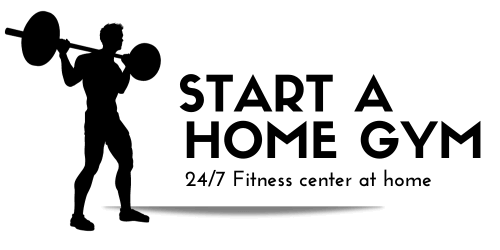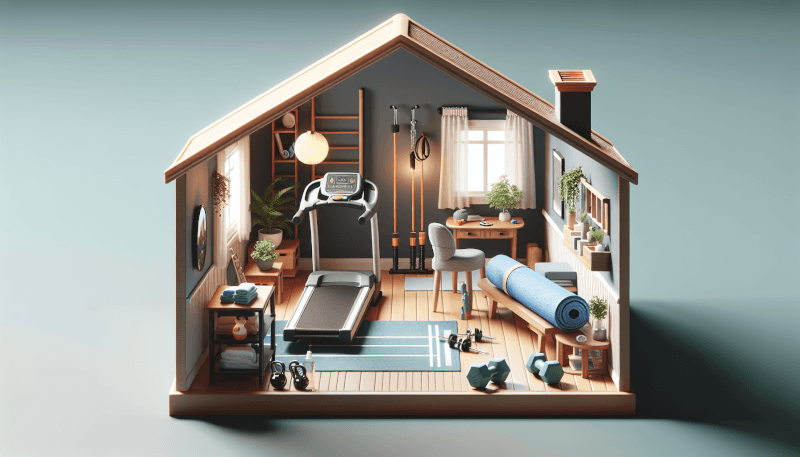Have you ever considered setting up your own home gym but weren’t sure about the costs involved? Well, in this article, we will walk you through the process of calculating the cost of setting up a home gym. From equipment to flooring to maintenance, we will break down all the factors you need to consider to determine the total cost. So, whether you’re a fitness enthusiast or someone who simply wants the convenience of working out at home, this article will provide you with the information you need to make an informed decision about creating your perfect at-home fitness space.
Choosing the Right Space
Evaluate available space
When setting up a home gym, the first step is to evaluate the available space in your home. Consider the size of the room or area where you plan to set up your gym and ensure that it is spacious enough to accommodate the equipment you intend to purchase. Take measurements and note any obstacles or limitations that may affect the layout and organization of your gym.
Consider the equipment you intend to purchase
After assessing the available space, it’s important to consider the specific equipment you plan to purchase for your home gym. Think about your workout goals and the types of exercises you enjoy. Are you primarily interested in strength training, cardiovascular exercises, or a combination of both? This will help you determine the types of equipment that will best suit your needs.
Determine the layout and organization
Once you have evaluated the space and identified the equipment you want to include in your home gym, it’s time to determine the layout and organization. Think about how you will arrange the equipment to maximize efficiency and ensure a safe workout environment. Consider factors such as the flow of movement, accessibility to different equipment, and the need for any additional storage solutions.
Selection of Equipment
Identify your workout goals
Before making any equipment purchases, it’s important to clearly identify your workout goals. Do you want to build strength, increase endurance, improve flexibility, or achieve specific fitness milestones? Understanding your goals will help you select the equipment that will best support your overall fitness journey.
Research different types of equipment
There is a wide range of exercise equipment available on the market, each designed to target different muscle groups and cater to various fitness levels. Take the time to research the different types of equipment that align with your workout goals. Look into the benefits and features of each piece of equipment to make an informed decision.
Consider the quality and durability
When investing in exercise equipment for your home gym, it’s essential to consider the quality and durability of each item. High-quality equipment will not only provide a better workout experience but also last longer, saving you money in the long run. Read customer reviews, consult with fitness professionals, and look for reputable brands known for their durability.
Compare prices and read reviews
As with any purchase, it’s important to compare prices and read reviews before making a final decision. Look for sales, discounts, or special offers to help stretch your budget. Additionally, reading reviews from other customers can provide valuable insights into the performance and reliability of the equipment you are considering.
Decide on necessary equipment
After conducting thorough research and considering your workout goals, it’s time to make a decision on the necessary equipment for your home gym. Select items that will provide a well-rounded and comprehensive workout routine. This may include strength training equipment, cardiovascular exercise machines, free weights, and resistance bands, among others. Choose equipment that suits your preferences, budget, and available space.
Budgeting
Set a realistic budget
Before embarking on your home gym journey, it’s crucial to set a realistic budget. Consider how much you are willing to invest in your fitness goals and allocate funds accordingly. Setting a budget will help guide your decision-making process and prevent overspending.
Allocate funds for equipment, accessories, and maintenance
When creating your budget, it’s important to allocate funds not only for the equipment itself but also for accessories and maintenance. Gym accessories such as exercise mats, towels, water bottles, and heart rate monitors are essential for a comfortable and effective workout. Additionally, consider the costs associated with regular maintenance and upkeep of your equipment to ensure its longevity.
Consider long-term costs
While the initial purchase of equipment is a significant investment, it’s also important to consider the long-term costs associated with owning a home gym. Factor in potential expenses such as equipment repairs, replacement parts, and upgrades. Taking these costs into account will help you better plan your budget and avoid any financial surprises down the road.
Account for additional expenses (e.g., flooring, mirrors)
In addition to equipment costs, it’s essential to account for any additional expenses that may arise when setting up your home gym. This could include the cost of installing suitable flooring for exercise, mirrors to monitor your form, or even air conditioning or fans to ensure a comfortable workout environment. Assess which additional expenses are necessary for your specific needs and adjust your budget accordingly.
Look for sales, discounts, or used equipment
To get the most value for your money, it’s worth exploring options for sales, discounts, or purchasing used equipment. Many fitness equipment retailers offer seasonal sales or promotions that can significantly lower the cost of equipment. Additionally, consider checking online marketplaces or classified ads for individuals selling their used gym equipment at a fraction of the original price.
Equipment Costs
Strength training equipment
Strength training equipment encompasses a wide range of options, including weight machines, power racks, benches, and squat racks. The cost of strength training equipment can vary significantly depending on the brand, quality, and features. It’s important to invest in equipment that is both safe and effective for your specific needs.
Cardiovascular exercise machines
From treadmills and elliptical trainers to stationary bikes and rowing machines, cardiovascular exercise machines are popular additions to any home gym. Prices for these machines can vary based on the brand, features, and overall quality. Consider your fitness goals, available space, and budget when choosing the right cardiovascular exercise machine for your home gym.
Free weights and dumbbells
Free weights and dumbbells are versatile and effective tools for strength training. They can be purchased individually or as a set, depending on your preferences and budget. Keep in mind that the cost of free weights and dumbbells will depend on the weight increments and the material they are made from.
Resistance bands and stability balls
Resistance bands and stability balls are affordable and portable options for adding variety to your workouts. These versatile accessories can target different muscle groups and provide an effective full-body workout. The cost of resistance bands and stability balls is relatively low, making them a budget-friendly addition to any home gym.
Multi-functional equipment
Multi-functional equipment, such as weight benches with built-in resistance bands or adjustable dumbbells, can help save space and provide a variety of exercises. While the initial cost of this type of equipment may be higher, it can often replace the need for multiple pieces of equipment, offering cost and space savings in the long run.
Accessories and storage solutions
Accessories such as exercise mats, gym towels, water bottles, heart rate monitors, and music systems can enhance the overall workout experience and motivate you during your exercise sessions. The cost of accessories will depend on the specific items you choose, but it’s important to include these in your budget to create a well-equipped and comfortable home gym. Additionally, consider investing in storage solutions such as wall-mounted racks or cabinets to keep your equipment organized and maximize space efficiency.

Optional Add-Ons
Entertainment systems
To make your home gym experience more enjoyable, consider adding entertainment systems such as a television or speakers. These can be used to watch workout videos, listen to music, or keep yourself entertained during longer exercise sessions. The cost of entertainment systems will depend on your preferences and the quality of the audiovisual equipment you choose.
Home gym flooring
Investing in suitable flooring for your home gym is essential to ensure safety and protect your floors from damage. There are various flooring options available, including rubber mats, foam tiles, and interlocking floor systems. The cost of home gym flooring will depend on the size of your gym space and the type of flooring you choose.
Mirrors
Mirrors are not only functional but also visually enhance a home gym space. They allow you to monitor your form during exercises and check your progress as you achieve your fitness goals. The cost of mirrors will vary depending on their size and quality. Consider the dimensions of your gym space and your personal preferences when choosing the right mirrors for your home gym.
Air conditioning or fans
Maintaining a comfortable temperature during your workouts is important to ensure an enjoyable exercise experience. Depending on your climate and personal preference, you may want to invest in air conditioning or fans for your home gym. The cost of air conditioning or fans will depend on the size of your gym space and the type of cooling system you choose.
Lighting
Good lighting is essential for safety and visibility during workouts. Consider installing bright and adjustable lighting fixtures in your home gym to create an inviting and well-illuminated environment. The cost of lighting will depend on the type of fixtures, their quality, and the size of your gym space.
Soundproofing
If you live in an apartment or have shared walls, soundproofing your home gym can help minimize noise disturbances for yourself and your neighbors. Depending on the level of soundproofing you require, the cost can vary. Consider options such as acoustic panels, soundproofing foam, or heavy curtains to reduce noise transmission.
Consider Maintenance and Repairs
Regular cleaning and upkeep
Regular cleaning and upkeep of your home gym equipment are essential for both hygiene and longevity. Refer to the manufacturer’s instructions for cleaning recommendations and ensure that you clean and sanitize the equipment regularly. This will help prevent the buildup of dirt, sweat, and bacteria, prolonging the lifespan of your equipment.
Equipment servicing and repairs
Despite regular maintenance, it’s possible that your home gym equipment may require servicing or repairs at some point. Always refer to the manufacturer’s warranty guidelines and follow their recommendations for servicing. Additionally, have a plan in place for repairs that may fall outside of the warranty period. Research local repair services and consider budgeting for any potential repair costs.
Warranty coverage
When purchasing home gym equipment, be sure to review the warranty coverage provided by the manufacturer. Familiarize yourself with the warranty period, what it covers, and any conditions or limitations. Understanding the warranty terms will give you peace of mind in case any unexpected issues arise with your equipment.

Professional Installation
Do-it-yourself vs hiring professionals
When setting up your home gym, one crucial decision is whether to do the installation yourself or hire professionals. While it may be tempting to save money and attempt a DIY installation, it’s important to consider the complexity of the equipment and your own skills and knowledge. If you are unsure or concerned about safety, it’s advisable to hire professionals who can ensure proper assembly and minimize the risk of accidents or equipment damage.
Research affordable installation options
If you decide to hire professionals for the installation, it’s worth researching affordable options in your area. Obtain quotes from different installation companies and compare their services and prices. Look for reputable providers who have experience in setting up home gyms and can offer reliable and efficient installation services.
Ensure proper assembly and safety precautions
Whether you choose to install the equipment yourself or hire professionals, it’s important to ensure proper assembly and adhere to safety precautions. Read and follow the manufacturer’s instructions carefully to minimize the risk of accidents and maximize the performance of the equipment. If you have any doubts or questions, don’t hesitate to reach out to the manufacturer or installation professionals for guidance.
Additional Accessories
Exercise mats and padding
Exercise mats and padding are essential accessories for any home gym. They provide cushioning and support, reducing the risk of injuries during floor exercises and providing a comfortable surface for stretching or yoga. The cost of exercise mats and padding will vary depending on the size, thickness, and quality of the materials used.
Gym towels and hygiene products
To maintain proper hygiene in your home gym, it’s important to have gym towels and hygiene products readily available. Consider investing in sweat-wicking towels, antibacterial wipes, and hand sanitizers to keep your equipment and yourself clean during workouts. The cost of gym towels and hygiene products will depend on the specific items you choose.
Water bottles and hydration systems
Staying hydrated during workouts is crucial for performance and overall well-being. Invest in durable water bottles or consider hydration systems such as hydration backpacks or water bottle attachments for your exercise equipment. The cost of water bottles and hydration systems will vary depending on the brand and features.
Heart rate monitors and fitness trackers
Heart rate monitors and fitness trackers can provide valuable data on your workout intensity and progress. These devices can track metrics such as heart rate, calories burned, and steps taken, helping you monitor your fitness goals. The cost of heart rate monitors and fitness trackers will depend on the specific features and technology they offer.
Music systems and speakers
For many people, working out with music can be motivating and enhance the overall experience. Consider investing in a music system or portable speakers for your home gym. These can be connected to your smartphone or music player, allowing you to enjoy your favorite music while exercising. The cost of music systems and speakers will depend on the brand and audio quality.
Consider Space Optimization
Utilize wall-mounted storage solutions
To maximize space efficiency in your home gym, consider utilizing wall-mounted storage solutions. Wall racks, hooks, or shelves can provide a convenient and organized way to store smaller equipment such as resistance bands or yoga mats. This will help free up floor space and keep your gym area tidy.
Explore foldable or compact equipment options
If space is a constraint in your home, consider exploring foldable or compact equipment options. Many exercise machines, benches, and bikes now offer space-saving features that allow them to be easily folded or stored away when not in use. Compact, multi-functional equipment can also be a great choice as it combines several exercises into one machine, reducing the overall footprint of your gym.
Maximize vertical space
Make use of the vertical space in your home gym by incorporating wall-mounted storage, mirrors, or even suspension trainers. Vertical storage options can help keep your equipment organized and readily accessible while maintaining a clutter-free floor area. Mirrors, when strategically placed on the walls, can create the illusion of a larger space and enhance the ambiance of your home gym.
Long-Term Cost Analysis
Evaluate potential savings
One of the benefits of setting up a home gym is the potential for long-term cost savings compared to a monthly gym membership. Evaluate the potential savings you can achieve by calculating the cost of a gym membership over several years and comparing it to the upfront investment for your home gym equipment. While there may be an initial higher cost, the long-term benefits can outweigh the expenses over time.
Compare monthly gym membership fees
To understand the potential savings of a home gym, compare the monthly fees of local gym memberships in your area. Consider the duration you plan to use the gym, and calculate the total cost of a membership over several years. This will give you a comparison point to gauge the cost-effectiveness of setting up a home gym.
Factor in transportation costs
When considering the long-term cost analysis, don’t forget to factor in transportation costs to and from the gym. Whether it’s expenses related to fuel, parking fees, or public transportation fares, these costs can add up over time. By eliminating the need to commute to a gym, a home gym can save you money in transportation expenses.
Consider time saved by having a home gym
Another valuable aspect to consider is the time saved by having a home gym. By avoiding the need to travel to and from a gym, you can allocate that time towards your workout session, allowing for longer, more consistent exercise routines. Time saved can also result in increased productivity in other aspects of your life, making a home gym a valuable investment in your overall well-being.
In conclusion, setting up a home gym involves careful consideration of available space, equipment selection, budgeting, and long-term cost analysis. By following these guidelines and taking into account your personal fitness goals, preferences, and budget, you can create a well-equipped and functional home gym that will provide years of fitness enjoyment. Remember to research different equipment options, compare prices, and take advantage of sales or discounts. With proper planning and organization, your home gym will become a convenient and effective space to achieve your fitness aspirations.



